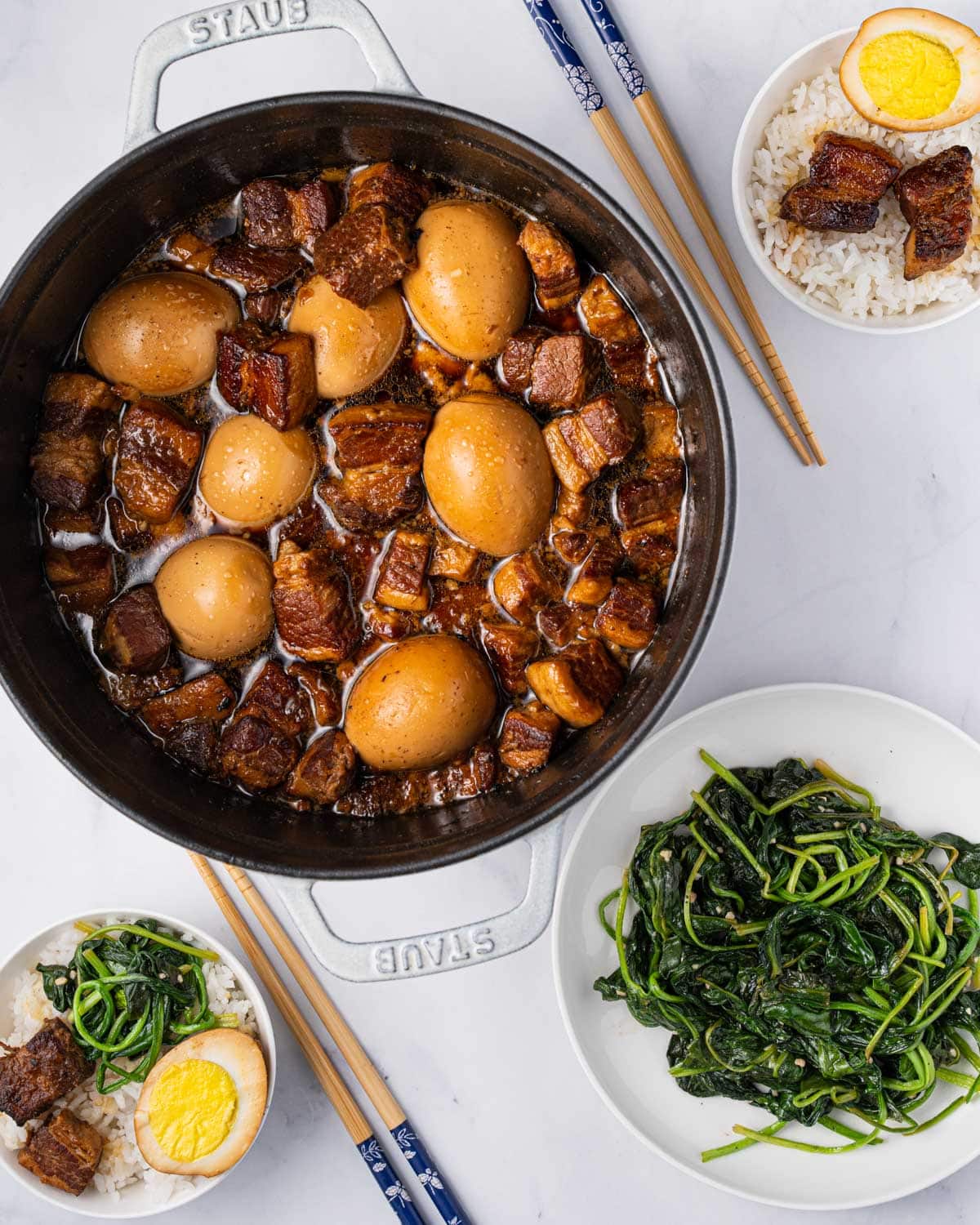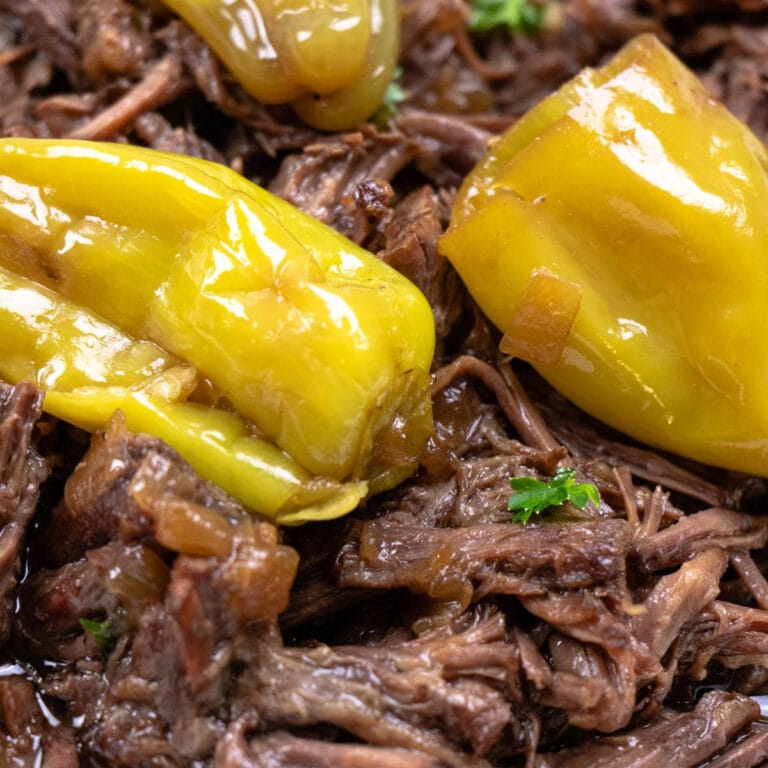Thịt Kho (Vietnamese Braised Pork and Eggs)
Thịt kho trứng (Vietnamese Braised Pork and Eggs) is a traditional Vietnamese sweet and salty simmered dish of pork and hard-boiled eggs braised in a savory coconut caramel sauce. This dish is a labor of love. The steps are simple, but patience is needed to allow the pork to tenderize in the braising sauce and soak up all the delicious flavors.

After years of experimenting with different recipes, we’ve finally come up with the perfect thit kho for our family (and hopefully yours, too)! Each household has its own distinct spin on this classic dish, but ours is simple to make (using simplified steps and easy-to-find ingredients) and super flavorful.
“Thịt,” in Vietnamese, means meat or pork. “Kho” is a term that is used to describe the process of simmering and braising. Traditionally, it was a popular cooking method used by culinary experts to create flavorful dishes with rich sauces. The process involves slowly cooking ingredients over low heat in a pot or pan filled with liquid. This technique allows the food to absorb all the flavors while preserving its tender texture.
Thit kho is just one of the many types of kho dishes in Vietnamese cuisine. Some other popular dishes include gà kho (braised chicken), tôm kho (braised shrimp), and cá kho tộ (braised fish in a clay pot).
Thit kho is a classic Vietnamese dish known for its comforting flavors and straightforward ingredients. Braised pork and eggs combine to create a hearty meal traditionally enjoyed with white rice. Often shared during special gatherings or celebrations like Lunar New Year, it embodies the spirit of Vietnamese communal dining.
More Easy Vietnamese Recipes to Try…
If you’re looking for more easy Vietnamese dinners, try my other favorites: mi xao gion (seafood pan fried noodles), hu tieu xao (stir fried beef noodles), com chien (fried rice with Chinese sausages and shrimp), xiu mai (Vietnamese meatballs), or banh xeo (Vietnamese Savory Crepes).
Vietnamese Culture Relating to Thit Kho
Thit kho is not just a popular, comforting dish for weeknight dinner—it also has many important roles in Vietnamese culture. Traditionally, it is served on special occasions like birthdays, weddings, and the Lunar New Year.
It can also be served with rice porridge and pickled vegetables for breakfast, making it ideal for starting the day right.
It is a part of Vietnamese culture that has been passed down through generations.
What Type of Pork Should I Use?
- Pork belly
- Pork shoulder
- Pork butt (Boston butt)
- Pork spare ribs
For thit kho, choose fattier cuts of pork, like pork belly or shoulder, to enhance the flavor and moisture of the dish.
Pork belly offers richness with its marbled fat, while pork shoulder boasts flavorful juices that keep the dish moist. Combine both cuts for a balanced texture and flavor.
For a healthier option, try a 50/50 blend of pork belly and pork shoulder. Pork ribs are another tasty choice, their succulent meat pairing perfectly with fish sauce and aromatics.
Avoid lean cuts like tenderloin or sirloin, which can dry out during braising. The choice of pork ultimately depends on personal preference, with each cut bringing its own unique flavors and textures to the dish.
What Kind of Eggs Should I Use?
Eggs are a popular ingredient that adds texture and flavor to the dish. The type of egg used can vary depending on personal preference and availability; however, the most common option is to use chicken, duck, or quail eggs.
What is the Best Brand of Fish Sauce?
Fish sauce is a key ingredient in Vietnamese cuisine, known for its robust flavor profile. Opt for a high-quality fish sauce made from fermented anchovies matured for 12-24 months, ensuring a savory-sweet taste. Look for brands like Red Boat, Three Crabs, or Squid Brand, which offer excellent options with minimal additives.
When selecting fish sauce for marinating and braising, choose one that suits your taste preferences. Three Crabs is a favorite for its balanced flavor, while Red Boat offers a more concentrated profile. Always do a taste test and adjust the amount of salt needed.

What is nước màu (Caramel Sauce)?
This isn’t the type of caramel sauce you drizzle over ice cream. Nước Màu, or caramel sauce, is a common ingredient in Southeast Asian cooking. It has a sweet and smoky flavor and is often used in “kho” recipes or as a topping for dishes such as noodles, curries, and salads. It can also be used to marinate meats before cooking. The texture is similar to a thick syrup.

You can find this at most Asian supermarkets, online, or you can make your own with this nước màu recipe. The recipe is also in the recipe card below.
Should I Use Coconut Water or Coconut Soda?
Traditionally, thịt kho uses coconut water, but people have added their own adaptions to this dish and have used coconut soda. It really comes down to your own personal preference.

Opt for an organic and sustainably sourced coconut water. Check the label for any added sugars or preservatives, as these can alter the dish’s flavor. Avoid the ones with coconut chunks or pieces in them. Always taste a small amount before adding it to your dish, as the flavor can vary significantly.

Coconut soda is another popular choice for this dish and my personal favorite. It contains 40g of sugar per serving, making this dish sweeter. The sugar and carbonate in the soda will naturally caramelize as it cooks and help tenderize the meat.
Gather These Ingredients

- Pork belly or pork shoulder, cut into 1 1/2 – 2 inch cubes
- Salt and pepper: For flavoring.
- Caramel sauce: Make your own with the recipe included, or buy it at the Asian grocery store.
- Fish sauce: Used to flavor the dish. My favorite brand is Three Crabs.
- Shallots and garlic: Aromatics for flavoring.
- Coconut water or coconut soda: Use canned or bottled. Use 4 cups for the stovetop version and 2 1/2 cups for the Instant Pot version.
- Hardboiled or softboiled eggs
Please scroll ⬇️ to the recipe card to see the full ingredient amounts and instructions.
Substitutions and Variations
- If you don’t want to use hardboiled eggs, you can skip them or substitute quail eggs.
- Instead of coconut water, use Rico coconut soda, Coca-Cola, or 7-up. The sugars from the soda will help caramelize the sauce and tenderize the meat. Soda has more sugar than coconut water, so you may need to adjust the amount used and season accordingly.
- Instead of fish sauce, substitute it with equal parts of soy sauce and vinegar or oyster sauce.
- Instead of pork belly or pork shoulder, try a combination of the two or try spare ribs. You can try beef (chuck roast) if you don’t eat pork.
- Instead of water, use chicken broth or water with chicken bouillon powder for more flavor.
- Instead of shallots, use yellow onions or scallions.
How to Make Thit Kho on the Stovetop

Please scroll ⬇️ to the recipe card to see the full ingredient amounts and instructions.
- Marinate the pork. In a large bowl, add pork, salt, pepper, and 2 tablespoons of fish sauce. Stir until well combined. Cover and let it marinate in the fridge for at least 20 minutes.
- Hard boil the eggs. In a large pot, add eggs and enough water to submerge the eggs fully. Place the pot on medium-high heat and cook the eggs for 12 minutes. Carefully drain the water and place the eggs in an ice bath. Peel the eggs and set them aside.
- Make the caramel sauce. (Note: The caramelization process happens quickly. Read the directions first before starting. Do not leave the stove unattended; have the water pre-measured before starting). Turn the stovetop to medium heat, and sprinkle sugar evenly over the surface of a small saucepan. Let it sit for 1-2 minutes without stirring. Once the sugar starts to melt, use a whisk or rubber spatula to stir constantly for 4-5 minutes (times will vary depending on your stovetop). You will see the sugar turning from clear to champagne yellow to a dark amber color. As soon as it starts smoking, immediately turn off the heat, pour in the water, and stir until the sugar is dissolved. Store in a jar with a lid and set it aside for later.
- Sear the pork. Place a large pot on medium heat and add oil. Working in batches, sear all sides of the pork. Add shallots and garlic and cook for 1-2 minutes.
- Add remaining ingredients. Add the remaining 2 tablespoons of fish sauce and caramel sauce, and stir to coat the meat in the sauce. Deglaze the pot with coconut water and water.
- Braise the pork. Cover with a lid and bring the pot to a boil. Then, lower the heat and let it simmer (covered) for 40 minutes, stirring occasionally. Put the eggs back into the pot and let it simmer (uncovered) for another 10-15 minutes. Rotate the eggs every few minutes. It is done when 1/3 of the liquid evaporates. Season to taste with fish sauce, sugar, or ground pepper.
Serve over rice. Enjoy!

Tips for Success
– Choose the right cut of pork. Choose a cut with a good meat and fat ratio if you’re using pork belly. If you’re using pork shoulder, choose a well-marbled cut (fat prevents the meat from drying out).
– Choose a high-quality fish sauce. That’s where all the flavor comes from.
– If you can, let the meat marinate overnight with the seasoning.
– Do not skip pan-searing the pork; the little browned bits equal lots of flavor!
– The secret to tender meat is cooking it low and slow. Low heat, simmering for a long time.
– When adding eggs, ensure they are cooked through but still have a slightly soft center. I like adding the eggs 10 minutes before the cooking ends, giving it enough time to let it soak in all the delicious flavor while not drying out the yolk. The egg will still continue to soak up the flavor off the stove.
– This dish is even better on the second day.
How to Make Instant Pot Thit Kho
Making thịt kho in an Instant Pot is a great way to enjoy the traditional Vietnamese dish with even less effort than usual. The Instant Pot can shorten the cooking time while still producing great results. Here’s how to do it:

Please scroll ⬇️ to the recipe card to see the full ingredient amounts and instructions.
- Marinate the pork. In a large bowl, add pork, salt, pepper, and 2 tablespoons of fish sauce. Stir until well combined. Cover and let it marinate in the fridge for at least 20 minutes.
- Hard boil the eggs. To the Instant Pot, add 1 cup of water and place 8 eggs on a trivet. Close the lid, ensuring the pressure release valve is in the sealing position. Press [Pressure Cook] on high pressure for 3 minutes. When the cooking time ends, let it naturally release pressure for 6 minutes, then Quick Release the rest of the pressure. Carefully place the eggs in an ice water bath for 5 minutes. Peel and set aside for later. Rinse out the pot.
- Make the caramel sauce. (Note: The caramelization process happens quickly. Read the directions first before starting. Do not leave the stove unattended; have the water pre-measured before starting). Turn the stovetop to medium heat, and sprinkle sugar evenly over the surface of a small saucepan. Let it sit for 1-2 minutes without stirring. Once the sugar starts to melt, use a whisk or rubber spatula to stir constantly for 4-5 minutes (times will vary depending on your stovetop) until it becomes dark golden brown in color. As soon as it starts smoking, immediately turn off the heat, pour in the water, and stir until the sugar is dissolved. Set it aside for later.
- Sear the pork. To the Instant Pot, press [Saute] and wait until the display says “hot.” Add oil. Working in 2 batches, sear the sides of pork and transfer it to a plate. Add shallots and garlic and cook for 1-2 minutes. Add in the remaining ingredients: pork, caramel sauce, and the remaining 2 tablespoons of fish sauce. Give it a good stir. Then, deglaze the pot with 2 1/2 cups of coconut water (scraping any bits stuck to the bottom of the pot to avoid the “burn” notice).
- Pressure cook. Close the lid, ensuring the pressure release valve is in the sealing position. [Pressure Cook] on high pressure for 6 minutes. Then, let it release pressure naturally. Open the lid, add the hardboiled eggs, and press [Sauté]. Let some of the liquid cook off and thicken, stirring occasionally, for approximately 5-6 minutes. Rotate the eggs every few minutes. Season to taste with fish sauce, sugar, or ground pepper.
Serve over rice. Enjoy!
What to Serve it With
Thit kho can be served with a variety of accompaniments. Steamed white rice or Vietnamese fried rice helps to absorb the dish’s savory and umami flavors.
Some other things to serve with it include:
- Pickled vegetables like pickled mustard greens, pickled carrots and daikon, pickled bean sprouts.
- Sauteed greens like rau muong (stir-fried water spinach in garlic)

FAQ
In Vietnamese, Thịt means “meat” and Kho is a Vietnamese cooking technique of braising. If you put it all together, thịt kho means braised meat.
Instead of coconut water, use Rico coconut soda, Coca-Cola, or 7-up. The sugars from the soda will help caramelize the sauce and tenderize the meat. Soda has more sugar than coconut water so you may need to adjust the amount used and season accordingly.
It will last for up to 4 days in the refrigerator or up to 3 months in the freezer.
How to Store Leftovers
Allow the thit kho to cool completely before storing it in an airtight container. Make sure that all of the ingredients are properly mixed throughout.
Refrigerate the thit kho for up to 4 days. Once you refrigerate this dish, all the fat will solidify at the top. You can skim this off if you wish.
Freeze it for up to 3 months. When you’re ready to eat it again, let it defrost in the fridge overnight.
Reheat: heat a skillet over medium heat and warm the pork until heated thoroughly. If frozen, let it thaw out in the fridge overnight before reheating.
RECIPE

Thịt Kho – Vietnamese Caramelized Braised Pork and Eggs
Ingredients
For the Caramel Sauce (Nước Màu)
- 4 tablespoons sugar
- ⅓ cup water
For the Braised Pork (Thịt Kho)
- 2 pounds pork shoulder or pork belly, skin on or off cut into 1 ½ inch cubes
- 1 teaspoon salt
- ½ teaspoon pepper
- 2 tablespoons caramel sauce
- ¼ cup fish sauce
- ½ tablespoon olive oil
- 2 shallots, finely diced
- 3 garlic cloves, minced
- 4 cups coconut water (Only use 2 ½ cups for Instant Pot)
- ¼ cup water
- 8 hard boiled eggs
- steamed rice, for serving
Instructions
Stovetop Version
- Marinate the pork. In a large bowl, add pork, salt, pepper, and 2 tablespoons of fish sauce. Stir until well combined. Cover and let it marinate in the fridge for at least 20 minutes.
- Hardboil the eggs. In a large pot, add eggs and enough water to fully submerge the eggs. Place the pot on medium-high heat and cook the eggs for 12 minutes. Carefully drain the water and place the eggs in an ice bath. Peel the eggs and set it aside.
- Make the caramel sauce. (Note: The caramelization process happens quickly. Read the direction first before starting. Do not leave the stove unattended and have the water pre-measured before starting). Turn the stovetop to medium heat, and sprinkle sugar evenly over the surface of a small saucepan. Let it sit for 1-2 minutes without stirring. Once the sugar starts to melt, use a whisk or rubber spatula to stir constantly for 4-5 minutes (times will vary depending on your stovetop). You will see the sugar turning from clear to champagne yellow to a dark amber color. As soon as it starts smoking, immediately turn off the heat, pour in the water, and stir until the sugar is dissolved. Store it in a jar with a lid and set it aside for later.
- Sear the pork. Place a large pot on medium heat; add oil. Working in batches, sear all the sides of the pork and transfer onto a plate. Add shallots and garlic and let it cook for 1-2 minutes.
- Add remaining ingredients. Add the remaining 2 tablespoons of fish sauce and caramel sauce, and stir to coat the meat in the sauce. Deglaze the pot with coconut water and water.
- Braise the pork. Cover with a lid and bring the pot to a boil. Then, lower the heat and let it simmer (covered) for 40 minutes, stirring occasionally. Put the eggs back into the pot and let it simmer (uncovered) for another 10-15 minutes. Rotate the eggs every few minutes. It is done when 1/3 of the liquid evaporates. Season to taste with fish sauce, sugar, or ground pepper.
- Serve over rice.
Instant Pot Version
- Marinate the pork. In a large bowl, add pork, salt, pepper, and 2 tablespoons of fish sauce. Stir until well combined. Cover and let it marinate in the fridge for at least 20 minutes.
- Make the caramel sauce. (Note: The caramelization process happens quickly. Read the directions first before starting. Do not leave the stove unattended and have the water pre-measured before starting). Turn the stovetop to medium heat, and sprinkle sugar evenly over the surface of a small saucepan. Let it sit for 1-2 minutes without stirring. Once the sugar starts to melt, use a whisk or rubber spatula to stir constantly for 4-5 minutes (times will vary depending on your stovetop) until it becomes dark golden brown in color. As soon as it starts smoking, immediately turn off the heat, pour in the water, and stir until the sugar is dissolved. Store it in a jar with a lid and set it aside for later.
- Hard boil the eggs. To the Instant Pot, add 1 cup of water and place 8 eggs on a trivet. Close the lid, ensuring the pressure release valve is in the sealing position. Press [Pressure Cook] on high pressure for 3 minutes. When the cooking time ends, let it naturally release pressure for 6 minutes, then quick release the rest of the pressure. Carefully place the eggs in an ice water bath for 5 minutes. Peel and set aside for later. Rinse out the pot.
- Sear the pork. To the Instant Pot, press [Saute] and wait until the display says "hot". Add oil. Working in 2 batches, sear the sides of pork and transfer it to a plate. Add shallots and garlic and cook for 1-2 minutes until fragrant. Add in the remaining ingredients: pork, caramel sauce, and remaining 2 tablespoons of fish sauce. Give it a good stir. Then, deglaze the pot with 2 cups of coconut water (scraping any bits stuck to the bottom of the pot to avoid the "burn" notice).
- Pressure Cook. Close the lid, ensuring the pressure release valve is in the sealing position. [Pressure Cook] on high pressure for 6 minutes. Then, let it release pressure naturally. Open the lid, add the hardboiled eggs, and press [Sauté]. Let some of the liquid cook off and thicken, stirring occasionally, for approximately 5-6 minutes. Rotate the eggs every few minutes. Season to taste with fish sauce, sugar, or ground pepper.
- Serve over rice.
Notes
Helpful Tips
- Choose the right cut of pork. If you’re using pork belly, choose a cut that has a good ratio of meat and fat. If you’re using pork shoulder, choose a cut that is well-marbled (fat prevents the meat from drying out).
- Choose a high-quality fish sauce. That’s the secret ingredient in this dish!
- If you can, let the meat marinate overnight with the seasoning.
- Do not skip pan-searing the pork. That’s where all the flavors will develop.
- The secret to tender meat is cooking it low and slow.
- When adding eggs, ensure they are cooked through but still have a slightly soft center. I like adding the eggs 15 minutes before the cooking time ends, which gives it just enough time to let it soak in all the delicious flavor while not drying out the yolk. The egg will still continue to soak up the flavor off the stove.
- This dish is even better on the second day.







Great recipe! The eggs, simmered alongside the pork, absorb the rich sauce, making them incredibly flavorful. I just served it for dinner and the family loved it. Thanks!
I made this recipe in the Instant Pot. The pork was extremely tender, and the sauce was so delicious. Yum!
My son and his wife have just returned from a 2 month mission in Vietnam and they have been raving about the food.
It was their wedding anniversary at the weekend and I made them a feast to celebrate. This was definitely the star of the menu!! It was amazing.
I used pork belly like you suggested and bought my caramel sauce at an Asian grocery store. Next time I will try making me own.
Cannot believe how amazing it was! I will remaking it again for sure.
It was my first time making this, and so happy that it turned out great! The pork was tender, and the eggs soaked up the savory sauce really well. I paired it with some cauli rice, and it was very satisfying! Definitely adding this to my go-to dishes!
I recently prepared this thit kho recipe for dinner, and I must say, I was absolutely delighted with the results! The pork was incredibly tender and bursting with flavor, and the caramel sauce was the perfect touch that elevated the entire dish to a whole new level. I’m already looking forward to making it again!
I’m so intrigued by this dish! The flavors seem incredibly unique, especially the coconut water, and I can’t wait to try them out. Thanks for introducing me to something new and exciting recipe!
I have never heard of this dish, and learned a lot from this post. It looks delicious and the instructions are very thorough. Thanks for sharing.
So many great tips and detail about the ingredients. I feel confident making this recipe and I know that my family will love it!
Ooh. I’ve never had kho before. I would love to try it. It’s full of just about everything I love!
Oh yum, a favorite! You had me at savory coconut caramel sauce. So many wonderful flavors packed into this dish.
Delicious and juicy tender meat. I love how flavourful it is. Everyone loved it and we don’t even need to order take out.
What a delicious and flavorful recipe this is. Thanks for sharing.
The recipe looks delicious and very satisfying. Definitely a must try high protein recipe. Thanks for sharing.
Thanks for the caramel sauce tips. That’s really useful.